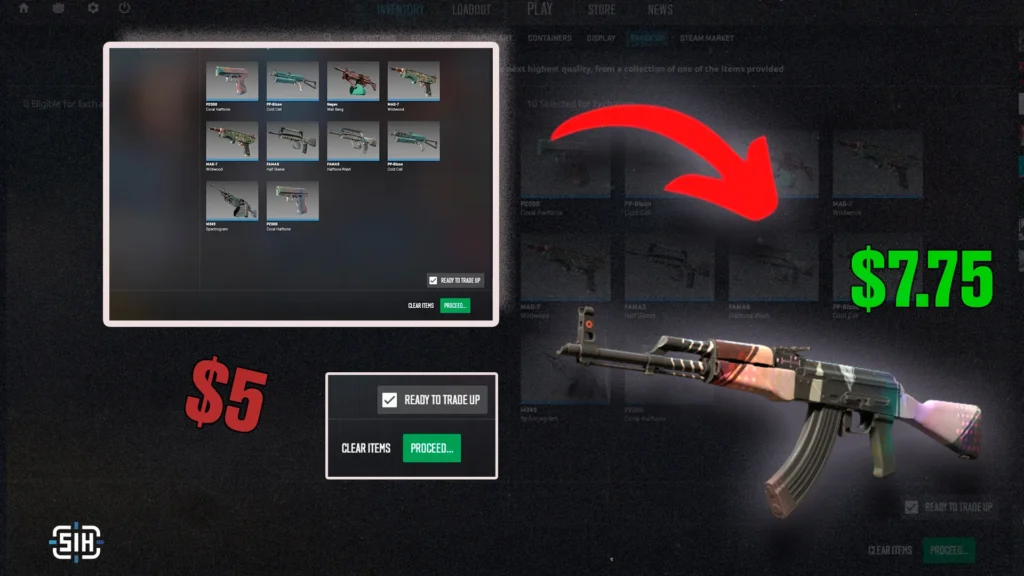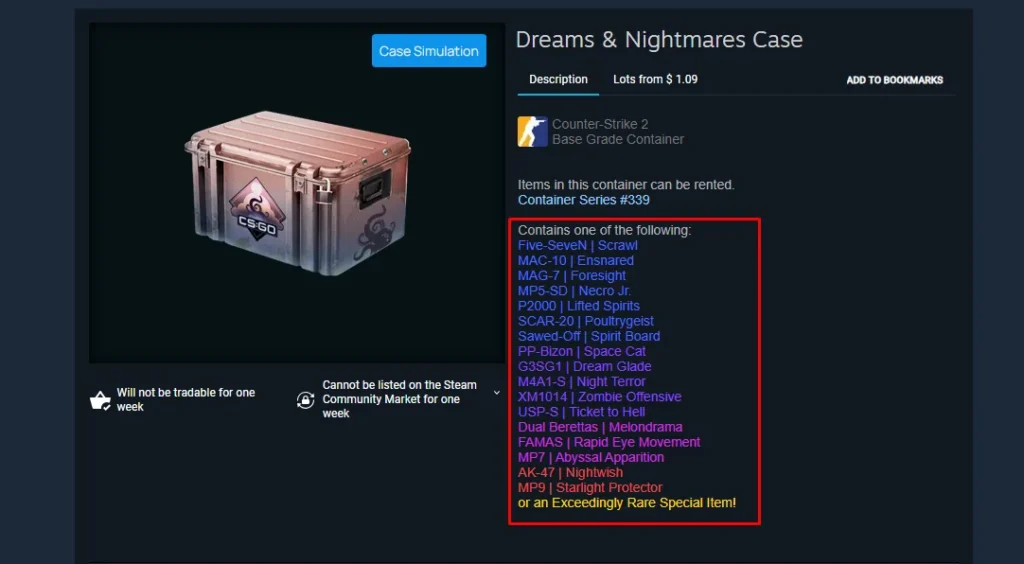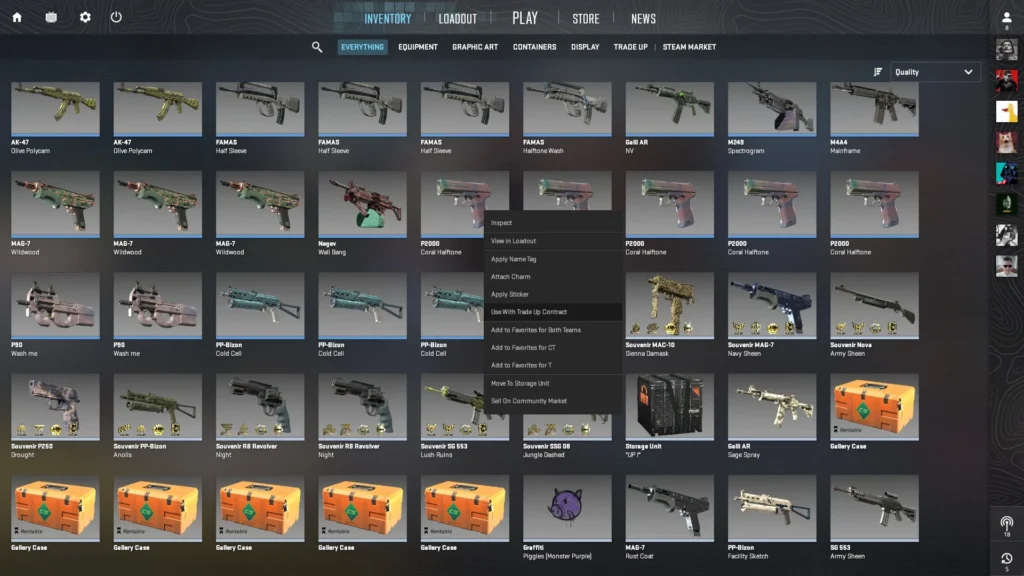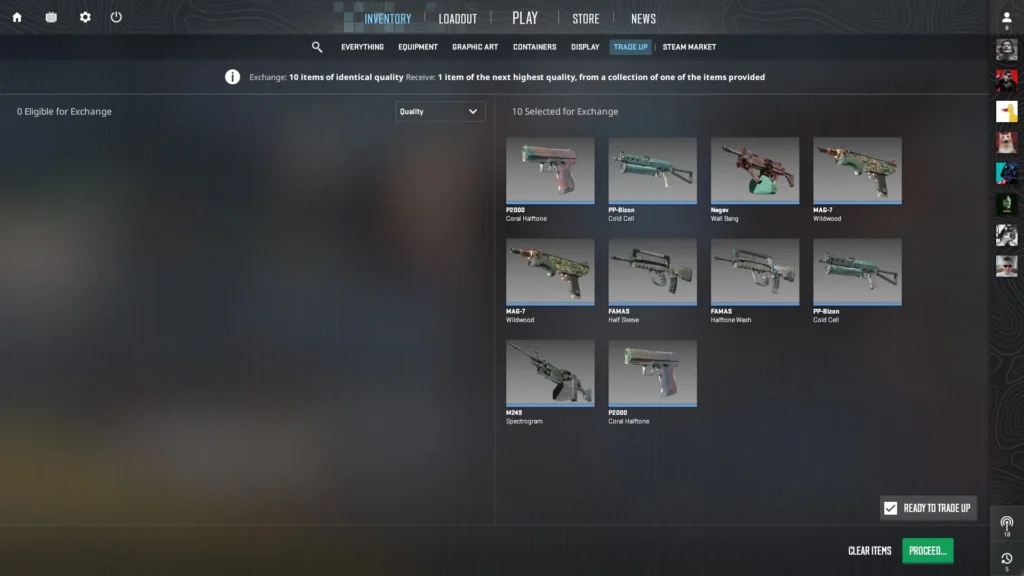How Do Trade-Up Contracts Work in CS2? Why Are Crafting Contracts a Cornerstone of Skin Culture?

In Counter-Strike 2, crafting new items is achieved through trade-up contracts, which allow players to exchange 10 items of the same quality for one item of a higher quality. This mechanic offers the chance to obtain rare and valuable skins. However, the outcome is always random, meaning you may not get the desired item. That said, it’s incorrect to assume the process is entirely luck-based—you can calculate the probability of obtaining specific skins based on the items you choose for the trade-up. This article delves into the mechanics of trade-up contracts, their purpose in the game, and who should consider utilizing this feature.
Mechanics of Trade-Up Contracts
Steps to Create a Trade-Up Contract:
- Collect 10 skins of the same quality (e.g., 10 Military Grade or 10 Restricted items).
- Open the trade-up contract menu in the game.
- Place the selected skins into the contract.
- Confirm the trade and receive a random skin of the next quality tier. For example:
- 10 Industrial Grade items will yield 1 Military Grade item.
- 10 Restricted items will produce 1 Classified skin.
How to Predict the Outcome

The chance of receiving a specific skin depends on the number of possible outcomes within the corresponding collection. For instance, if a collection contains five skins of a given quality, the probability of obtaining any specific skin is 20%.
Example: If you use 10 skins from the Dreams & Nightmares Case (all of the same quality, e.g., blue-grade skins), there are five purple-grade skins in the case. You will receive one of these purple-grade skins, each with an equal 20% chance.
Mixing Skins from Different Collections
If you combine skins from various collections, the probability splits accordingly.
Example: You create a trade-up contract for a Classified item using:
- 3 Restricted skins from the Dreams & Nightmares Case,
- 4 from the Killowatt Case,
- 3 from the Fracture Case.
The probability of receiving a Classified skin from each case is proportional to the input:
- 40% for Killowatt,
- 30% for Dreams & Nightmares,
- 30% for Fracture.
Since each case contains two Classified skins, divide these percentages by two to calculate the specific probabilities:
- 20% for each skin from the Killowatt Case,
- 15% for each skin from the other two cases.
Items Excluded from Trade-Ups
- Souvenir items,
- Knives,
- Gloves,
- Skins with the highest rarity in their collection (usually Classified or Restricted).
For StatTrak weapons, all skins used in the contract must also have the StatTrak feature.
Skin Wear and Float Values
The wear of the skins used in the contract affects the wear of the resulting item:
- Using all Factory New items almost guarantees a Factory New outcome.
- Mixing wear levels requires calculating the average float value, which determines the wear of the resulting skin.
Tip: Avoid mixing wear levels significantly, as one poorly-worn item can affect the appearance and value of the resulting skin.
Getting Rid of Low-Grade Items: Tips for Beginners

Trade-up contracts in Counter-Strike 2 not only allow players to acquire rarer skins but also serve as a convenient tool for clearing unwanted low-grade items from your inventory. Instead of selling cheap skins individually or letting them collect dust, you can bundle them into a contract to transform them into a more valuable item.
Advantages of Using Trade-Up Contracts for Low-Grade Items:
- Inventory Organization: Declutter your inventory by trading multiple cheap items for a single, more valuable one.
- Potential Profit: Even low-value skins can be traded for a skin that’s significantly more valuable.
- Aesthetic Upgrade: If you don’t profit financially, you might still end up with a visually appealing item.
- Convenience: Complete a trade-up with just a few clicks, avoiding the hassle of managing marketplace sales.
Strategies and Recommendations
- Choose Skins from the Same Collection: This maximizes your chances of obtaining the desired item.
- Market Analysis: Study skin prices beforehand to identify profitable combinations.
- Evaluate Risks: Keep in mind that the outcome is random, and you might not receive the desired skin. Only invest what you can afford to lose.
- Focus on Collection Rarity: Use multiple skins from the same rare collection to increase your chances of obtaining a high-value item.
Is Crafting Worth It? An Example of a Profitable Trade-Up

Achieving a 100% profitable trade-up is nearly impossible, as popular items for crafting are well-known and often expensive. These skins, known as “trade-up fodder,” are held specifically for crafting or investment purposes, often being older pink-grade skins from retired collections.
So why craft at all?
- It’s one of the most efficient ways to clear low-value items.
- Even a 5–10% chance of profit is better than the odds of unboxing a Restricted item from a case.
Example: To craft an AWP | Atheris, use:
- 10 Galil AR | War Horn skins (Field-Tested, $0.24 each).
- The total cost is around $2.40, and the chance of obtaining the AWP (Field-Tested, $5–6 value) is approximately 16.6%.
While not guaranteed, this probability is significantly higher than unboxing a similar item at the same cost.
Why Are Trade-Up Contracts Essential in CS2 Skin Culture?
At first glance, trade-up contracts might seem like a revenue-generating feature for developers, but their real purpose lies in market balance. Without trade-ups, the supply of items would continuously grow, devaluing skins over time. By creating demand for lower-tier items, trade-ups introduce scarcity to certain collections, especially those no longer in active drops. Every trade-up not only gives players a shot at obtaining a rare skin but also helps maintain market stability.

Alex
Alex is an author and esports observer with more than seven years of experience. He specializes in analyzing new releases in the world of computer games, gaming services, and in-game economies. Alex shares practical experience and an expert perspective on the development of gaming, helping readers understand complex mechanics and stay up to date with the latest news.